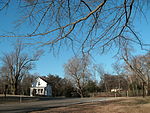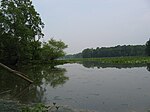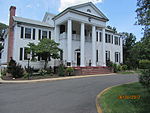Accokeek Creek Site
Accokeek, MarylandArchaeological sites in Prince George's County, MarylandArchaeological sites on the National Register of Historic Places in MarylandNational Historic Landmarks in MarylandNational Register of Historic Places in Prince George's County, Maryland ... and 3 more
Native American history of MarylandPiscatawaySusquehannock

Accokeek Creek Site, also known as Moyaone, is an archaeological site in Prince George's County, Maryland, located along the Potomac River across from Mount Vernon in today's Piscataway Park, which was inhabited intermittently since 2000 BC. Accokeek Creek Site was declared a National Historic Landmark in 1964.
Excerpt from the Wikipedia article Accokeek Creek Site (License: CC BY-SA 3.0, Authors, Images).Accokeek Creek Site
Mockley Point Road,
Geographical coordinates (GPS) Address Nearby Places Show on map
Geographical coordinates (GPS)
| Latitude | Longitude |
|---|---|
| N 38.696027777778 ° | E -77.051833333333 ° |
Address
Mockley Point Road
Mockley Point Road
20607
Maryland, United States
Open on Google Maps










